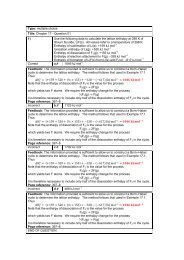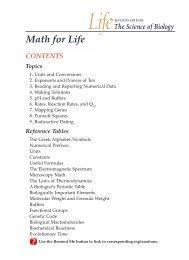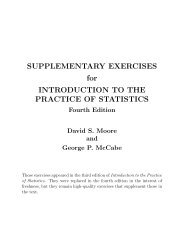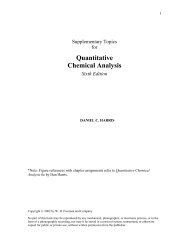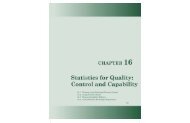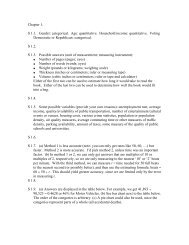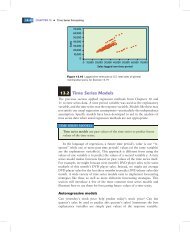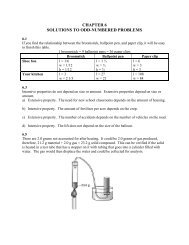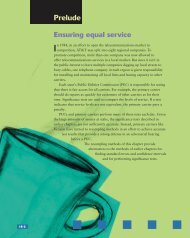Chapter 3 - Experimental Error - WH Freeman
Chapter 3 - Experimental Error - WH Freeman
Chapter 3 - Experimental Error - WH Freeman
You also want an ePaper? Increase the reach of your titles
YUMPU automatically turns print PDFs into web optimized ePapers that Google loves.
54<br />
3 <strong>Experimental</strong> <strong>Error</strong><br />
The real rule: The first uncertain figure<br />
is the last significant figure.<br />
The rationale for finding the uncertainty<br />
in the molecular mass of NH 3 is<br />
explained at the end of this chapter:<br />
N: 14.006 74 0.000 07<br />
3H: 3(1.007 94 0.000 07)<br />
N: 14.006 74 0.000 07<br />
3H: 3.023 82 0.000 21<br />
NH 3 : 17.030 56 20.000 07 2 0.000 21 2<br />
17.030 5 6 0.000 2 2<br />
17.030 6 0.000 2<br />
Convert absolute uncertainty to %<br />
relative uncertainty for multiplication.<br />
The Real Rule for Significant Figures<br />
The first uncertain figure of the answer is the last significant figure. For example, in the<br />
quotient<br />
the uncertainty (0.000 2) occurs in the fourth decimal place. Therefore, the answer is<br />
properly expressed with three significant figures, even though the original data have<br />
four figures. The first uncertain figure of the answer is the last significant figure. The<br />
quotient<br />
is expressed with four significant figures because the uncertainty occurs in the fourth<br />
place. The quotient<br />
0.821 (0.002)<br />
1.022 (0.004)<br />
0.803 (0.002)<br />
is expressed with four figures even though the dividend and divisor each have three<br />
figures.<br />
Example<br />
Significant Figures in Laboratory Work<br />
You prepared a 0.250 M NH 3 solution by diluting 8.45 (0.04) mL of 28.0 (0.5)<br />
wt % NH 3 [density 0.899 (0.003) g/mL] up to 500.0 (0.2) mL. Find the<br />
uncertainty in 0.250 M. The molecular mass of NH 3 , 17.030 6 g/mol, has negligible<br />
uncertainty relative to other uncertainties in this problem.<br />
SOLUTION To find the uncertainty in molarity, we need to find the uncertainty in moles<br />
delivered to the 500-mL flask. The concentrated reagent contains 0.899 (0.003) g<br />
of solution per milliliter. The weight percent tells us that the reagent contains<br />
0.280 (0.005) g of NH 3 per gram of solution. In the following calculations, we<br />
retain extra insignificant digits and round off only at the end.<br />
Grams of NH 3 per<br />
mL in concentrated<br />
reagent<br />
0.002 364 (0.000 003)<br />
0.025 00 (0.000 05)<br />
0.002 664 (0.000 003)<br />
0.025 00 (0.000 05)<br />
0.899 (0.003) g solution<br />
mL<br />
0.899 (0.334%) g solution<br />
mL<br />
0.251 7 (1.82%) g NH 3<br />
mL<br />
0.094 6 (0.000 2)<br />
0.106 6 (0.000 2)<br />
g NH 3<br />
0.280 (0.005)<br />
g solution<br />
g NH 3<br />
0.280 (1.79%)<br />
g solution<br />
because 2(0.334%) 2 (1.79%) 2 1.82%.<br />
Next, we find the moles of ammonia contained in 8.45 (0.04) mL of<br />
concentrated reagent. The relative uncertainty in volume is 0.04/8.45 0.473%.<br />
0.251 7 (1.82%) g NH 3<br />
mL<br />
mol NH 3 <br />
17.030 6 (0%) g NH 3<br />
mol<br />
0.124 9 (1.88%) mol<br />
8.45 (0.473%) mL<br />
because 2(1.82%) 2 (0.473%) 2 (0%) 2 1.88%.<br />
This much ammonia was diluted to 0.500 0 (0.000 2) L. The relative<br />
uncertainty in the final volume is 0.000 2/0.500 0 0.04%. The molarity is





